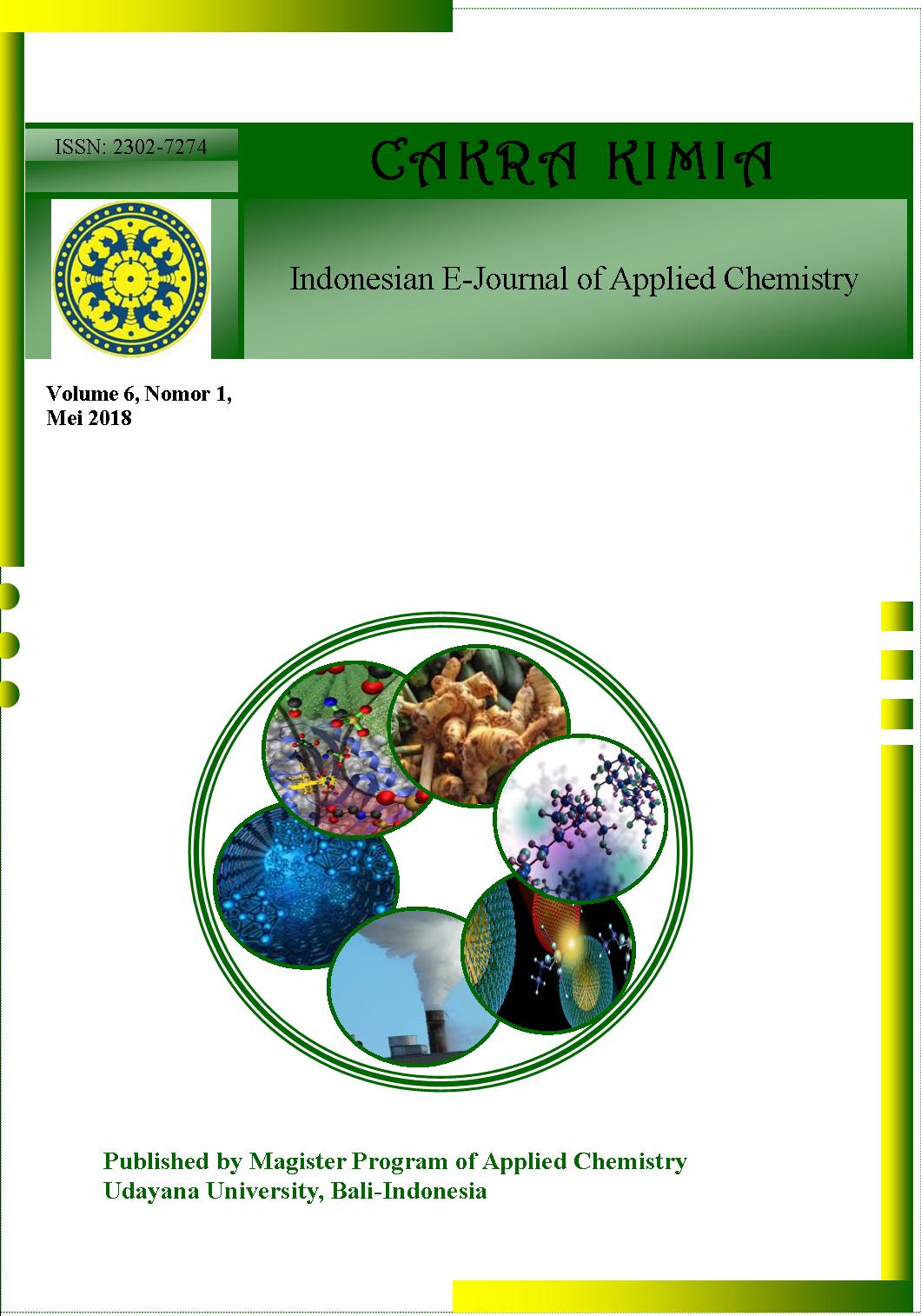AKTIVITAS ANTIBAKTERI EKSTRAK KULIT PISANG (Musa sp.) TERHADAP Escherichiacoli DAN Staphylococcus aureus SERTA IDENTIFIKASI GOLONGAN SENYAWA AKTIFNYA
Abstract
ABSTRAK: Kulit pisang (Musa sp.) dapat digunakan sebagai bahan penghambat bakteri. Penelitian ini bertujuan untuk mengetahui aktivitas antibakteri kulit pisang (Musa sp.) terhadap Escherichia coli dan Staphylococcus aureus serta identifikasi senyawa aktifnya.. Ekstraksi dilakukan dengan teknik maserasi dengan etanol, selanjutnya ekstrak etanol dipartisi berturut-turut dengan n-heksana, etilasetat, dan n-butanol. Ekstrak n-heksana, etil asetat, dan n-butanol, yang diperoleh diuji fitokimia dan aktivitas penghambatan terhadap bakteri Escherechia coli dan Staphylococcus aureus. Uji penghambatan bakteri dilakukan dengan metode sumur difusi pada media Nutrient Agar (NA).Ekstraksi 500 g kulit pisang (Emas, Kepok, Susu dan Kayu) masing-masing menghasilkan 15, 20, 10, 12 gram ekstrak pekat yang berwarna kuning. Hasil uji fitokimia menunjukkan bahwa ekstrak kulit pisang mengandung senyawa alkaloid, terpenoid, fenol dan flavonoid. Hasilujiaktivitas terhadap bakteri Escherechia coli dan Staphylococcus aureus menunjukkan bahwa ekstrak kulit pisang Mas dan Kepok adalah ekstrak yang aktif dengan MIC masing masing 1% dan 0,5%, untuk kulit pisang mas dan 0,5% serta 0,1%, untuk kulit pisang kepok.
Kata Kunci: Antibakteri, Musa sp., Escherichia coli, Staphylococcus aureus, Minimum Inhibitory Concentration (MIC)
ABSTRACT: The banana peel (Musa sp.) can be used as antibacteria. This study aims to determine the antibacterial activity of banana peel (Musa sp.) against Escherichia coli and Staphylococcus aureus and to identify their active compounds. Extraction was done by maceration technique with ethanol, then ethanol extract was partitioned successively with n-hexane, ethylacetate, and n –butanol to get n-hexane, ethyl acetate, and n-butanol extract. The extract was tested phytochemical and activity of against Escherichia coli and Staphylococcus aureus. The antibacterial activity test was performed by diffusion well method on Nutrient Agar (NA) medium. Extraction of 500 g banana peel (Mas, Kepok, Susu and Kayu) each produced 15, 20, 10, 12 grams of yellow-colored concentrated extract. The phytochemical test results showed that banana peel extract contains alkaloids, terpenoids, phenols and flavonoids. The antibacterial activity test of the banana peels against Escherechia coli and Staphylococcus aureus showed that banana extract of Mas and Kepok was the active extract with MIC 1% and 0.5%, for mas and 0.5% and 0,1%, for kepok peel.
Downloads
References
[2] Jawetz E., J. L. Melnick, E. A. Adelberg, G. F. Brooks, J. S. Butel, L. N. Ornston., MikrobiologiKedokteran, ed. 20, University of California, San Francisco.
[3] Mandal, A, 2012, What is Staphylococcus aureus?
URL:http://www.news-medical.net/health/What-is- Staphylococcus-aureus.aspx.
[4] Mokbel, M.S. and Hashinaga, F., ,2005, Antibacterial and Antioxidant Activities of Banana (Musa, AAA cv. Cavendish) Fruits Peel. American Journal of Biochemistry and Biotechnology, 1(3): 125-131.
[5] Ehiowemwenguan, G., Emoghene, A. O.’1and Inetianbor, J.E., 2014, Antibacterial and phytochemical analysis of Banana fruit peel, IOSR Journal Of Pharmacy, 4(8): 18-25.
[6] Ardiansyah, Daun Beluntas sebagai Bahan Antibakteri dan Antioksidan.2005. Available from: http://www.berita_iptek.com/ cetak_ beritahp? kat=berita &id=33.
[7] Rita, W.S, 2009, Penapisan Fitokimia dan Uji Toksisitas Ekstrak Rimpang Temu Putih (Curcuma zedoaria Rosc.). Medicina, 40(2): 104-108
[8] Ningsih, A,P., Nurmiati,dan Agustien, A., 2013, Uji Aktivitas Antibakteri ekstrak kental tanaman pisang kepok kuning ( Musa paradisiaca Linn) terhadap S Aureus dan E Coli, Jurnal Biologi Universitas Andalas 2(3).207-213.
[9] Faradhila, 2015, Uji aktivitas antibakteri kulit pisang kepok ( Musa balbisiana) terhadap bakteri penyebab jerawat (S. Epidermisdis, S Aureus dan propioni bacterium acne) UIN Syarif Jakarta
[10] Khopkar, S.M, 1990, Konsep Dasar Kimia Analitik. Jakarta: Universitas Indonesia, p. 216-217.
[11] Marliana, E., 2007, Analisis Senyawa Metabolit Sekunder dari Batang Spatholobus ferrugineus (Zoll & Moritzi) Benth yang Berfungsi sebagai Antioksidan. Jurnal Penelitian MIPA. 1(1): 23-29.



 Petunjuk Penulisan
Petunjuk Penulisan
